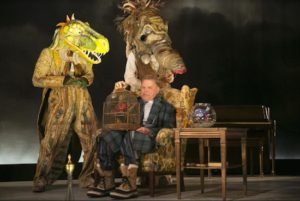In today’s Wall Street Journal I review a major Brooklyn revival of The Skin of Our Teeth. Here’s an excerpt.
* * *
Thornton Wilder’s “The Skin of Our Teeth” is the Great White Whale of American theater, a masterpiece that nobody has seen. That’s not strictly true, of course: It still gets done by amateur troupes, and ambitious regional companies also take it on from time to time. But “The Skin of Our Teeth,” which was first performed on Broadway in a 1942 production directed by Elia Kazan and starring Tallulah Bankhead, Montgomery Clift and Fredric March, calls for a cast of 30, thus making it prohibitively costly to produce commercially today. It hasn’t been seen on Broadway since a 1975 revival that closed after seven performances….
For all these reasons, Theatre for a New Audience’s Brooklyn revival would be a major event even if it weren’t any good—and it is, praise be, quite extraordinarily good. Directed by Arin Arbus in a lively, imaginative manner that is faithful both to the spirit and the letter of Wilder’s text, this production triumphantly reestablishes “The Skin of Our Teeth” as one of the finest American plays of the 20th century…
 More than most plays, you have to see “The Skin of Our Teeth” to appreciate its virtues. On paper it can sound twee, a historical pageant disguised as a “You Can’t Take It With You”-type knockabout comedy featuring the Antrobuses, a seemingly ordinary middle-class family whose members aren’t quite so ordinary as they seem. It emerges that Mr. Antrobus (David Rasche) is, among other things, the inventor of the alphabet and the wheel, that he, his wife (Kecia Lewis), his two children (Kimber Monroe and Reynaldo Piniella) and their maid (Mary Wiseman) are all 5,000 years old, more or less, and that the first act takes place during the Ice Age, which is why the Antrobus’ pets are a mammoth and a dinosaur. In the second act, they cope with the Great Flood, while the third picks up their story immediately after World War II….
More than most plays, you have to see “The Skin of Our Teeth” to appreciate its virtues. On paper it can sound twee, a historical pageant disguised as a “You Can’t Take It With You”-type knockabout comedy featuring the Antrobuses, a seemingly ordinary middle-class family whose members aren’t quite so ordinary as they seem. It emerges that Mr. Antrobus (David Rasche) is, among other things, the inventor of the alphabet and the wheel, that he, his wife (Kecia Lewis), his two children (Kimber Monroe and Reynaldo Piniella) and their maid (Mary Wiseman) are all 5,000 years old, more or less, and that the first act takes place during the Ice Age, which is why the Antrobus’ pets are a mammoth and a dinosaur. In the second act, they cope with the Great Flood, while the third picks up their story immediately after World War II….
Wilder sought to remind his viewers that humankind has survived unimaginable horrors throughout its long, bloody history, and will—or, rather, can—continue to prevail so long as it can muster the courage to push back against the darkness. The words he puts in Mr. Antrobus’ mouth in the final scene leave no doubt of his purpose: “I know that every good and excellent thing in the world stands moment by moment on the razor-edge of danger and must be fought for—whether it’s a field, or a home, or a country.”
If that speech sounds the least little bit preachy…well, it is. But Wilder took care to steer clear of sermonizing elsewhere by making most of “The Skin of Our Teeth” a wonderfully fanciful romp, a theatrical mixtape into which snippets of “Finnegans Wake” and the Book of Genesis, as well as a dollop of “Our Town,” are spliced….
It wouldn’t be hard—especially now—to superimpose an up-to-the-second High Directorial Concept (#resist, anyone?) on Wilder’s near-childlike optimism. To her infinite credit, Ms. Arbus declines the invitation. Instead, she turns her cast loose on Riccardo Hernandez’s wide-open set, most of which amounts to a giant gable and two walls, and encourages them to speak Wilder’s lines with an energy and simplicity of intent that are unspoiled by gratuitous cleverness….
* * *
Read the whole thing here.
A video featurette about the first rehearsal of Theatre for a New Audience’s The Skin of Our Teeth:
A 1959 Granada Television production of the first two acts of The Skin of Our Teeth, directed by Henry Kaplan and starring Vivien Leigh as Sabina and George Devine as Mr. Antrobus. This was Leigh’s only TV performance:

 I deeply admire Mr. Burton for quitting while he’s still—as far as the rest of us can tell—at the top of his game. Too many performing artists find it impossible to walk away from the stage, even after their powers have been diminished to the point of public embarrassment by advancing age. (That’s what happened to Anita O’Day, whose last public performances were a pitiful debacle.) Not so Mr. Burton. He’s retiring the way he’s lived, with courage and grace….
I deeply admire Mr. Burton for quitting while he’s still—as far as the rest of us can tell—at the top of his game. Too many performing artists find it impossible to walk away from the stage, even after their powers have been diminished to the point of public embarrassment by advancing age. (That’s what happened to Anita O’Day, whose last public performances were a pitiful debacle.) Not so Mr. Burton. He’s retiring the way he’s lived, with courage and grace….
